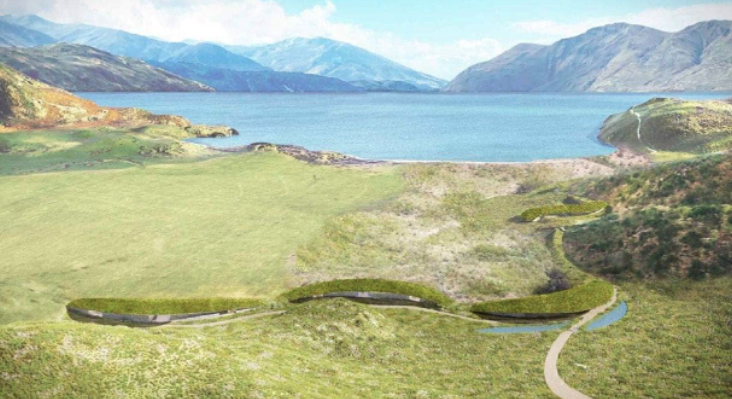Few community benefits to billionaire’s Wānaka lodge plans, submitters say
Maddy Harker
24 May 2022, 6:06 PM
 Peter Thiel’s proposal for a luxury lodge in Damper Bay was considered by independent commissioners at a two-day resource consent hearing which concluded yesterday. The US billionaire has proposed a series of buildings stretching 330m across the ONL-zoned site.
Peter Thiel’s proposal for a luxury lodge in Damper Bay was considered by independent commissioners at a two-day resource consent hearing which concluded yesterday. The US billionaire has proposed a series of buildings stretching 330m across the ONL-zoned site.“A good landowner would build a house in the wonderful location where the already consented building platform is on the site”, a submitter said at yesterday’s (Tuesday May 24) resource consent hearing on Peter Thiel’s proposal for a luxury lodge in Wānaka.
The submission, made by Julian Howarth, formed part of a colourful two-day hearing on the US billionaire’s proposal to construct a lodge for visitor accommodation and personal use at a quiet Damper Bay property he purchased in 2015.
The famously private tech mogul is seeking approval to construct three buildings (via his company Second Star Ltd) spanning 330m in length, totalling almost 2,000sqm, and designed to sleep as many as 30 people, which would be built partially into the hillside and obscured by living green roofs.
The Outstanding Natural Landscape (ONL) zoning of the 198ha property, which Thiel purchased for $13.5M, presented numerous challenges for his legal team, who must convince the commissioners the development is reasonably difficult to see and that the merits of the project outweigh its disadvantages.
The Queenstown Lakes District Council (QLDC) planner who recommended the development be refused told the commissioners yesterday she stands by her recommendation, despite being accused by the applicant’s lawyer Mike Holm of her report having an “air of negativity”, “almost…a predetermined ‘no’”, and “somewhat relentless misplaced criticisms”.
Sarah Gathercole reiterated her assessment to the commissioners: “The positive effects don’t outweigh the negative effects of the proposal.”
This perspective was echoed by a number of others, who said that any benefits to the local tourism economy, via visitor spending, or to the land, via native regeneration and enhancement, didn’t cut it.

Submitters questioned whether the living green roof would survive drought, disease or fire, and how other ancillary additions like car parking for up to 60 people, would affect the look of the property
“Does spending lots of money in the local economy mean that you get to adversely affect the ONL?” Dunedin lawyer Phil Page, representing John May, asked, while John’s landscape witness Stephen Brown likened the project’s positives to “a small band aid on a large wound”.
Rough Milne Mitchell landscape architect Brooke Mitchell described a “world class lodge” built within a “rich tapestry of rocky outcrops” and camouflaged with “very organic” living green roofs.
But questions about ancillary requirements - like car parking for up to 60 vehicles, outdoor living areas, a new access driveway, and a requirement to prevent light spill at night - took some charm out of the vision, as did discussion on whether the green roof could ever feasibly mimic the natural environment, and what the effect might be if it was affected by drought, disease or fire.
Julian, who is the secretary for environmental watchdog group the Upper Clutha Environmental Society, said Thiel might choose not to use the proposed lodge for hired visitor accommodation.
“The applicant could build the entire complex, costing many millions, and leave it empty. It could be a conference centre, it could be an events centre, it could be a nuclear bolthole.”
Without certainty the development would be used for visitor accommodation, the economic benefits and perhaps the landscape benefits would be thrown into doubt, he said.
The UCES successfully opposed development on the site previously proposed by a former owner, and Julian said there were many reasons the current proposal did not tick the necessary boxes.
“It will not be reasonably difficult to see when viewed by the many thousands of boaters on the lake annually, or the many thousands using the walking track.”
Propositions of ecological enhancement and regeneration through extensive planting (which commissioner Ian Munro asserted had not been measured in a quantifiable way) was another source of contention for Julian.
“I accept there are positive effects of the regeneration…but this should not be used to justify an inappropriate development,” he said.
“A good landowner would build a house in the wonderful location where the already consented building platform is on the site…that’s what should happen.”
The two-day resource consent hearing wrapped up yesterday but commissioners Ian Munro, Wendy Baker and councillor Glyn Lewers have requested more detailed plans before deciding whether to grant permission.
PHOTOS: Supplied



